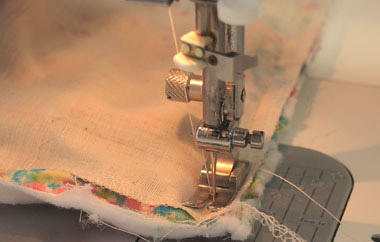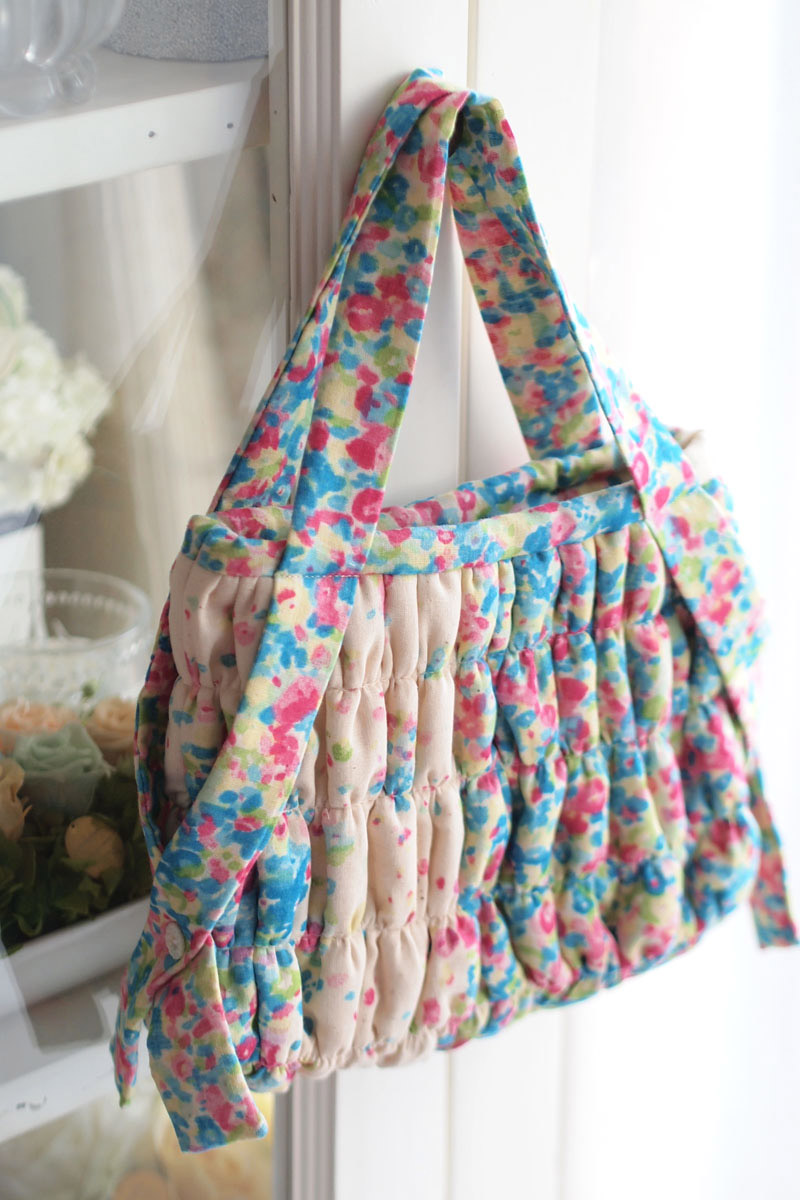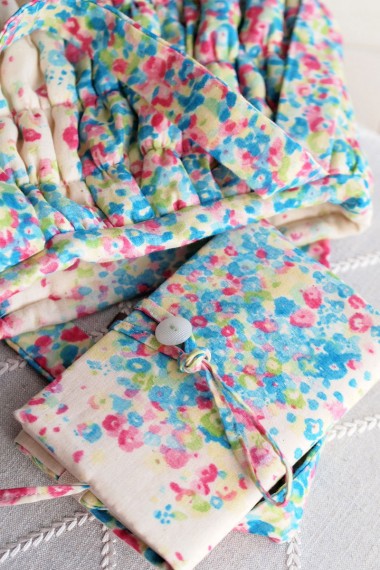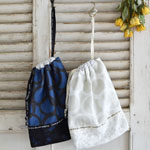The featured bag makes the best use of the softness of the fluffy double gauze fabric, Fuwari fuwari from the naniIRO series.
“I took advantage of the softness of the double gauze fabric combined with a domett interlining to create gathering that delivers the fabric’s texture and beautiful patterns. Though the size is smaller, it is sized to fit a Japanese paperback. With a wallet and handkerchief inside, it is perfect for a quick walk or an outing.” (by rocco*)
Fabric shown for this sample:naniIRO Fuwari fuwari JG10410 (A) Hikari No Sono
Materials:
□ Fabric: 80cm×80cm
□ Fusible interfacing (thin): 80cmx50cm
□ Domett Interlining (thin): 60cmx50cm
□ Button: Two pieces (1.3cm diameter)
We interviewed rocco* about her creation:
Kokka Fabric (KF): What did you think of the fabric you used for this project?
The fabric, Fuwari fuwari*Hikari No Sono from Hiromi Ito’s naniIRO series, is so stylish with its color gradation and patterns. I thought that making something dimensional would make it more attractive, so I got the urge to make a bag, though double gauze fabric is not normally recommended for this types of item. Once I started, I realized that this fabric was more solid with less skewing than other type of double gauze. It was easy to sew, making my work easier. I took advantage of the softness of the double gauze fabric combined with a domett interlining to create gathering that delivers the fabric’s texture and beautiful patterns.
KF: Can you tell us any special elements or ideas that you incorporated into this creation?
I maximized the use of the gradation of colors and pattern along with the soft texture of double gauze fabric. The fabric is placed to accentuate the contrast of the colors. The soft texture is even enhanced by combining it with domett interlining and gathering, while giving more strength to a frail gauze fabric.
The subdued yet glamorous design is one of a kind, perfect for the naniIRO series that is celebrating its 15th anniversary. The top opening is treated as part of the lining fabric, rather than using a bias binding tape and will not require stitches around the opening. The handles will be added later after turning the bag inside out. At first, it may look difficult to make, but it is constructed with these easy-to-follow steps.
KF: What are some tips for making this bag?
Pre-washing or soaking in water and ironing and aligning the edge will prevent skewing of the fabric. When sewing, use needles for knit sewing to prevent damage to the fabric. The bag’s character, gathering of the fabric and domett interlining, can be best created by making it somewhat irregular rather than making it perfect. In this way the color gradation will appear more rich and interesting.
KF: How should we use this bag in everyday situations?
Going into an early summer season, I think it will look stylish when combined with a white-colored wardrobe. The bag is small, but big enough to hold a Japanese paperback. With a wallet and handkerchief inside, it is perfect for a quick walk or an outing.
KF: Thank you very much, rocco*! Here are sewing instructions along with step by step photos from her. Enjoy crafting!
Instructions
1.

Pre-wash or soak in water and iron and align the edge to prepare the fabric. Adhere interfacing to the outer fabric and handle. By going through this process, it will prevent a delicate double gauze fabric to be skewed while sewing.
Align the domett interlining on the back of the double gauze fabric with interfacing. Pin it in several locations and run rough stitches (5mm stitch size) at the top edge. To make a gathering, sew it straight through without running backstitches at the beginning and end.
For the domett interlining, run 5mm wide stitches in five locations with 5cm intervals in a horizontal direction against the vertical line of the fabric from the top edge. Again, sew it through without running backstitches at the beginning and end.
2.

Run rough stitches in six locations including the top edge. In the order from top to bottom, pull the thread at the beginning and end to create a gathering. It does not need to be perfectly even as irregularities create gathering with unique looks. After gathering the fabric, align the fabric to 24 (l)x 26cm(w) rectangular and secure the threads on the right and left with a clip to hold the gathering.
3.

Run 2mm stitches over all gathering stitch lines to secure the gathering. Use a stiletto to help push the fabric as you sew for a clean finish. Here again, do not worry about making it perfect. Now the outer fabric is ready.
4.

After making the outer fabric, sew together the outer and lining fabrics at the top opening with the front sides facing with each other. Serge the four corners of the gauze on the lining fabric. It prevents them from fraying as you sew and helps with the corner treatment later.
5.

Sew together the outer and lining fabrics and turn it inside out using the opening for turning. Wrap around the opening of the outer fabric with the lining fabric and close the opening for turning with hand stitches. After sewing, attach the handle. Since the handle is added after the bag is turned inside out, you have the flexibility of adjusting four handle attachment locations and the length. This avoids making mistakes with this process.
6.

Cross the long end of the right and left handles at a preferred location and attach a button by hand to finish.





 Fluffy Drawstring Bag in Double Gauze Fabric
Fluffy Drawstring Bag in Double Gauze Fabric Cami dress in double gauze fabric
Cami dress in double gauze fabric Fluffy Shoulder Bag
Fluffy Shoulder Bag